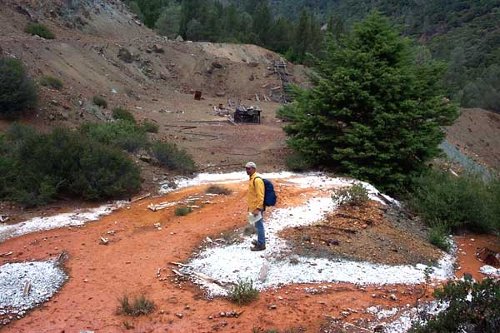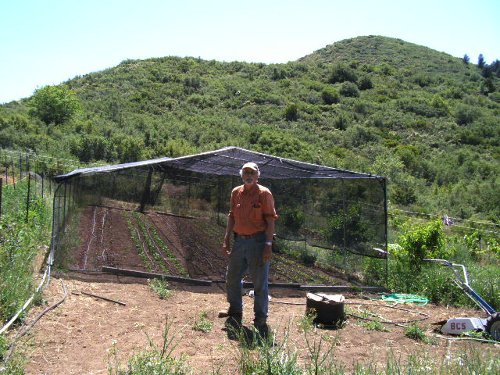
Mine effluent from the Helen mercury mine's main adit portal located to the left of photo. The brown sediment extends about 100 feet from the portal where it enters an erosional gully on route to Dry Creek. The content of the white precipitate has not yet been determined. During the late summer season, a whitish mineral precipitate forms on the surface of the mine tailings and then is subsequently washed away by winter storm events into Dry Creek, a tributary of Upper Putah Creek. Photo courtesy of the Bureau of Land Management.
MIDDLETOWN – The Bureau of Land Management is proposing a $1.7 million alternative to clean up an abandoned mercury mine, officials revealed at a community meeting Tuesday.
The BLM hosted a nearly 80-minute-long meeting at the Jesus Christ Fellowship on Pine Street to discuss plans for the Helen mercury mine cleanup.
The original mine site, located four and a half miles west of Middletown off Dry Creek Road, includes 35 acres that is a mix of private property and land managed by BLM, officials reported Tuesday.
Of special concern are three tributaries to Dry Creek that run through the site, which were discussed at the meeting. Dry Creek flows into Putah Creek and then into Lake Berryessa in Napa County.
Gary Sharpe, an associate field manager for the Ukiah BLM office who hosted the meeting, told Lake County News in a followup interview on Wednesday that the Helen mine is one of many in the region that are being studied for cleanup. On Monday, BLM held a meeting in Healdsburg to discuss two other mercury mines set for cleanup – the Contact and Sonoma mines.
“There are a lot of mercury mines in this state,” he said.
Two other mines are located in the same drainage as the Helen and directly upstream – the Chicago and Research – with Sharpe explaining that initial investigations are nearly completed on both. He said he hopes to have public meetings on those mines next year.
The Helen mine's draft final engineering evaluation and cost analysis prepared by Portland, Ore.-based Ecology and Environment Inc., the BLM's consultant on the mine cleanup, explained that the Helen, Research and Chicago mercury deposits are among the youngest in the Coast Range's mineral belt.
North of the Helen there are four or five more mercury mines, located on private land, Sharpe said. BLM also is working in Colusa County on three other mines – the Rathburn, Petray and Clyde – located in the Walker Ridge area.
Mercury was used for gold mining during the 19th century, and during World Wars I and II mercury production again rose as the highly explosive mercury fulminate was used for munitions, Sharpe said.
That boom in mercury production continued up through the 1950s as the arms race gained steam, he added.
While the Helen mine itself hasn't been a high priority, Sharpe said the concerns about the mercury from the mine has been an issue for the State Water Resources Control Board, which is trying to keep mercury out of the Bay Delta.
He said the mine was one of three that were eligible for stimulus funds due to being considered “shovel ready.”
Lenna Cope, a professional engineer with Ecology and Environment Inc., presented the mine's draft final engineering evaluation and cost analysis to the small crowd of about a dozen area residents on Tuesday.
Cope said the analysis included an expanded human health and ecological risk assessment for the mine.
The report explained that the mine was patented in 1874 by John Pershbaker, and then passed through a series of owners until it was nearly shut down in 1921. It continued through additional owners until it was sold in 1976 to Helen Mine, a joint venture between W.C. McCulloch and Richard R. Clements and Sons, according to the evaluation document.
Cope said the first report of mercury production, totaling 128 flasks – each weighing 76 pounds – was in 1873, followed by another 100 flasks by 1903.
In 1913, 5,000 flasks were reported, with the mine's main years of production taking place from 1903 to 1919. Cope said from 1919 to 1975 it produced another 7,000 flasks.
The US Geological Survey had conducted environmental sampling at the mine site in 2003, and Cope's firm took samples earlier this year of soil, sediment and biological resources for the study.
Cope said the site, as it is today, includes five main site features – a northern tailings pile, middle tailings pile, southern disturbed area, and storage tank and retort areas. Tailings are the materials left behind when mercury is extracted.
In places like the northern and middle tailings areas, the contaminated material is believed to be 33 feet deep, she said. However, the storage tank and retort areas had the highest mercury concentration, according to test results.
Water that drains from the mine's nearby adits – or entrances – is neutral, so it isn't contributing an acid load. However, Cope noted that it contains heavy metals.
Altogether, the mine has 6,800 cubic yards of contaminated materials – which Cope defined as materials that have mercury levels above the criteria established in the site's risk assessment. Cope said that amount of material isn't huge when compared to other mine sites.
Testing of the site's main features showed that the highest mercury concentrations were found in the northern tailings pile, with 1,100 milligrams per kilogram, compared to 7,900 millimeters per kilogram for the storage tank area, Cope reported. Those numbers are far higher than a sampling taken near the creek of 83 milligrams per kilogram.
Tests of the three Dry Creek tributaries showed that there was a source of mercury bioaccumulation upstream of the mine, which Cope wasn't any greater than the levels downstream.
For the human risk assessment, she said mercury was the principal contaminant of concern. No cyanide was found, but there were smaller amounts of arsenic detected.
Humans at the greatest risk for encountering mercury would be child campers, who Cope said would risk exposure of 355 milligrams per kilogram.
The greatest hazard for contamination was to terrestrial plans, she said.
The studies laid the groundwork for the response plan, which Cope said seeks to reduce human and ecological exposure.
They considered five alternatives, said Cope. The first was no action, which must be included and is used as a baseline for comparison to other options.
The second option, limited action, proposes construction of a diversion berm and channel system above the mine site to keep water from draining through it and into the creeks, Cope said.
That option, said Cope, also would include building rock pools in the stream, minor recontouring and stabilization of the slopes and institutional controls to prevent human contact, at an estimated total cost of $700,000.
The third alternative, and the one preferred by BLM, costs about $1.7 million and would consolidate all 6,800 cubic yards of contaminated materials from the tailings areas, retort, storage and southern disturbed area into one location, according to Cope.
Cope said permanent surface water diversion structures would be constructed, and there would be capping of the materials with 24 inches of clean materials and revegetation, with the slopes shaped to prevent sediment from moving.
The fourth alternative, which Cope said would cost about $2.2 million, is similar to alternative three, but would include a clay liner below the contaminated materials as well as above it, with a soil cap.
The fifth alternative was off-site disposal. Cope said that plan, estimated at $2.7 million, would require major road improvements in order for trucks to get in and out of the area, as well as excavation and materials transport to appropriate landfills, where they would have to pay tipping fees. The area then would be recontoured, revegetated and reclaimed.
All cost estimates, Cope noted, included ongoing monitoring.
Cope said the recommended alternative is No. 3, which does the best job of getting contamination away from surface water.
Sharpe said BLM will need to find more money to do the project, which will go out for bid through the US Fish and Wildlife Service.
An archaeologist working for BLM had conducted a survey of the area, which local archaeologist Dr. John Parker – representing the Lake County Heritage Commission – asked about at the meeting.
Parker noted that miners working at mines from the 1870s through the 1920s were primarily Chinese. He said archaeologists don't know much about the Chinese in Lake County, and the commission was concerned about the possibility of artifacts.
Sharpe said Wednesday that if he's able to get some additional stimulus funding he expects design work on the mine cleanup could begin this fall, with remediation beginning in the summer of 2011.
To see the Helen mine's draft final engineering evaluation and cost analysis prepared by Ecology and Environment Inc., visit www.blm.gov/ca/st/en/fo/ukiah/contact_sonoma_mines.html; there report begins halfway down the page.
Comments can be provided at the public meeting, through the BLM’s Web site at www.ca.blm.gov/ukiah, by email to This email address is being protected from spambots. You need JavaScript enabled to view it., by fax to 707-468-4027, or by mail to BLM Ukiah Field Office, 2550 N. State St., Ukiah, Calif., 95482.
E-mail Elizabeth Larson at This email address is being protected from spambots. You need JavaScript enabled to view it. . Follow Lake County News on Twitter at http://twitter.com/LakeCoNews and on Facebook at http://www.facebook.com/pages/Lake-County-News/143156775604?ref=mf .

 How to resolve AdBlock issue?
How to resolve AdBlock issue? 










